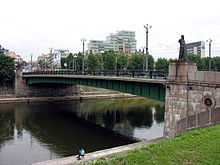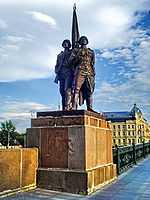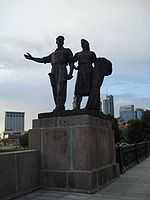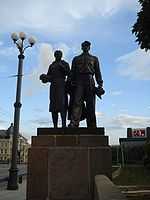Green Bridge (Vilnius)
| Green Bridge | |
|---|---|
 | |
| Coordinates | 54°41′29″N 25°16′47″E / 54.69139°N 25.27972°ECoordinates: 54°41′29″N 25°16′47″E / 54.69139°N 25.27972°E |
| Crosses | Neris River |
| Locale | Vilnius |
| Preceded by | Mindaugas Bridge |
| Followed by | White Bridge |
| Characteristics | |
| Total length | 102.9 metres (338 ft) |
| Width | 24 metres (79 ft) |
The Green Bridge (Lithuanian: Žaliasis tiltas) is a bridge over the Neris River in Vilnius, Lithuania. It is the oldest bridge in the city and connects city center with Šnipiškės.
History
The first bridge is known from 1536. It stood closer to the present-day Mindaugas Bridge. It was a wooden covered bridge with brick and stone piers. It had a second floor with apartments for toll collectors.[1] Because its builder Ulryk Hozjusz wanted to recoup the cost by collecting tolls, Grand Duke Sigismund I of Poland granted him a privilege prohibiting others to build any other bridges between Kernavė and Bistrica (Быстрыца in Belarus) or to offer other crossing services between Verkiai and Paneriai.[1] The bridge was burned by retreating Lithuanian Army commanded by Janusz Radziwiłł after the Battle of Vilnius (1655).[2]
A new project was prepared in 1673, which envisioned a span of 73 metres (240 ft) between piers—the longest known span at the time.[2] However, an early spring and ice jam destroyed the piers. Therefore the old piers from the first were reused and the second bridge was complete in 1679. In 1739 another wooden bridge was erected and painted green.[2] Since then it is known as the Green Bridge. In 1789 a new project of a brick bridge was prepared by Laurynas Gucevičius, but the builders selected another proposal.[1] The construction was supervised by Marcin Knackfus. The project was not successful as the bridge burned in 1791. It was rebuilt according to a project by Michael Schulz in 1805, but burned again on orders from Michael Andreas Barclay de Tolly during the French invasion of Russia of 1812.[2]
The bridge was rebuilt in 1827–1829. A steel bridge was designed by Nikolai Belelyubsky and completed in 1894.[2] It survived World War I, but was blown up by the Wehrmacht in 1944. The present-day bridge was completed in 1952 and named after Soviet General Ivan Chernyakhovsky. After the declaration of independence in 1990, the bridge regained its historical name.
Sculptures
The bridge features four sets of sculptures—prominent examples of Soviet realism. They all feature two people, representing social classes idealized by the Soviet authorities (soldiers, workers, farmers, students). Three sculptures are 3.2 metres (10 ft) in height (including the pedestal); the soldiers reach 4 metres (13 ft) due to the raised flag.[2]
-

Guarding Peace (Taikos sargyboje) by Bronius Pundzius
-

Agriculture (Žemės ūkis) by Bernardas Bučas and Petras Vaivada
-

Youth of Education (Mokslo jaunimas) by Juozas Mikėnas
-
.jpg)
Industry and Construction (Pramonė ir statyba) by Bronius Vyšniauskas and Napoleonas Petrulis
In 2013, a debate about the future of the Soviet-era statues pitted Lithuanian patriots against those who view the statues as historically significant artifacts. The latter included Artūras Zuokas, mayor of Vilnius, who in August 2013 announced a $200,000 plan to refurbish the statues without removing them from the bridge.[3]
References
| Wikimedia Commons has media related to Green Bridge (Vilnius). |
- ↑ 1.0 1.1 1.2 Drėma, Vladas (1991). Dingęs Vilnius (in Lithuanian). Vilnius: Vaga. p. 376. ISBN 5-415-00366-5.
- ↑ 2.0 2.1 2.2 2.3 2.4 2.5 Jurgis Bielinis et al., ed. (1988). Lietuvos TSR istorijos ir kultūros paminklų sąvadas (in Lithuanian) 1. Vilnius: Vyriausioji enciklopedijų redakcija. pp. 126–127.
- ↑ ^"Silent Sentinels at Center of Lithuanian Debate on Bygone Era." The New York Times. Nov. 11, 2013. Retrieved Nov. 16, 2008.